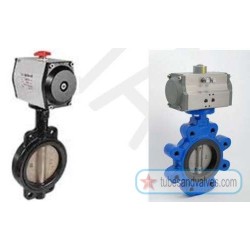An Overview of the Electrical Actuator Butterfly Valve
The electrical actuator butterfly valve is an amazing and powerful tool in the hands of engineers and technicians. This type of valve is a reliable, easy-to-use, and versatile piece of machinery that is perfect for applications that demand precise, rapid, and effective control over a wide range of flow rates and pressure settings. This guide provides an overview of the electrical actuator butterfly valve, including its benefits and applications.
Benefits and Advantages of Electrical Actuator Butterfly Valves
The biggest benefit of using electrical actuator butterfly valves is their speed and accuracy. Unlike manual valves that can take many turns of the handle to regulate pressure, the electrical actuator butterfly valve can provide precise control over the flow rate. Furthermore, when combined with advanced computer controlled systems, they can also provide precise and accurate control even over fluctuations in temperature, flow rates, and pressure.
This type of valve has the ability to regulate both high and low pressures. They are also highly versatile, capable of managing various types of fluids, gases, and other media. Additionally, they are relatively small, so they can fit into tight spaces and easily into production machinery. The reduced size and weight also makes them easier to transport and install.
Applications of Electrical Actuator Butterfly Valves
The primary application of electrical actuator butterfly valves is for regulating pressure in industrial applications. They can be used to adjust the rate of flow for anything from chemical processing to water treatment. The speed and accuracy of the valve make them suitable for use in high-pressure systems or those requiring precise control. They can also be found in many medical and automotive applications, where their versatility and reliability make them ideal.
The electricity used to activate the valve is either by direct current (DC) or alternating current (AC). Furthermore, they are capable of mixing a variety of signals, enabling control over even the most complex process control systems. Additionally, some models come with an integrated solenoid that can override manual changes to achieve even greater accuracy.
Common Features of Electrical Actuator Butterfly Valves
The typical features of an electrical actuator butterfly valve include a high flow capacity and fast response time. As mentioned above, they can be used to regulate high or low pressures, and are often accompanied by a wide range of installation accessories like mounting brackets and hoses for connection with other parts of the system. Furthermore, the valves often come with adjustable pressure and flow rate settings, allowing for better control over the process.
The valves also feature an adjustable range of motions, enabling them to move from an open to a closed position in only a few milliseconds. As mentioned earlier, some models come with an integrated solenoid, allowing for a precise control of even the most precise and complex processes. These valves are often highly corrosion-resistant, making them ideal for use in hazardous environments or with corrosive liquids.
Conclusion
The electrical actuator butterfly valve is an incredibly powerful and versatile tool in the hands of engineer and technicians. It provides precise, rapid, and effective control over a wide range of process parameters, and is suitable for a variety of industrial applications. It has the ability to adjust high and low pressures, and offers a wide range of motion and adjustable pressure settings. With its fast response time, reliability, and overall cost-effectiveness, the electrical actuator butterfly valve is an ideal choice for many industrial settings.
FAQs for Electrical Actuator Butterfly Valve
FAQs for Electrical Actuator Butterfly Valve
What is an Electrical Actuator Butterfly Valve?
An Electrical Actuator Butterfly Valve is a valve that regulates the flow of fluids or gases in a pipeline. It is operated by an electric motor that rotates the valve disc to control the flow.












































